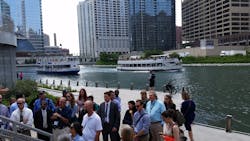Transport Chicago: Creating Vibrant Cities, Efficient Transportation
In its 32nd year, Transport Chicago continued its exchange of knowledge of more than 300 planners, transportation professionals, and the public and private sector. They come together to find solutions to challenges facing Chicago and other cities across the country.
Two-term Mayor of San Francisco Willie Brown gave his perspective of transportation from the political side. “Politicians don’t run for office talking transportation,” he said. “We don’t know what it means to the over-all quality of life; you have to help us understand.”
When running for office, he said there was a list of things high on the vote-getting list, including education, public safety, environment, housing, taxes … “You could run through 10 items and transportation isn’t in the 10.”
However, as mayor, he saw how transportation is integral to quality of life and how planning policy can complement it. Blending all transportation modes became a prime goal of city management. “Politicians need a commitment to elevate all types of transportation,” he stressed.”
An Exchange of Knowledge
Sessions throughout the day covered diverse topics around transportation, including funding, sustainability, optimization, advocacy and planning across all modes.
Ellen Gottschling with Sam Schwartz shared the information from a road map they developed with WSP for King County Metro to transition to a zero-emission bus fleet. Currently they have two fast-charging Proterra buses and will purchase 120 electric buses by 2020.
The common themes from meeting with departments across the agency, were that scalability of infrastructure is important, there’s complexity that the each bus doesn’t run the same route each day, and there needs to be an equity analysis.
The impact of the shared-use economy was a hot topic of discussion and Yoav Mordowic of Via Transportation, told how their smart on-demand transit is working in Chicago, New York, London and Washington, D.C.
They provide about one million rides a month in all the cities combined and have partnerships in other cities, including Paris with Keolis and SNCF and Austin, Texas, with Capital Metro, where they licensed the technology to Capital Metro.
They use virtual bus stops and the top priority is aggregating more people in shared vehicles with data being optimized daily. The base of the platform is predictive AI and learning-based matching.
The afternoon included a walking tour of the recently completed Chicago Riverwalk, a major public amenity along lower Wacker Drive, extending from Michigan Avenue to Lake Street, led by Project Manager Ozzie Chavez with the Chicago Department of Transportation and Construction Manager James Nutter with Bennsh, the resident engineer.
The majority of the river vessel traffic is recreational, including kayaks, tour boats and private boats, but there is also a lot of industrial/barge traffic and the Chicago Water Taxis.
Chicago Water Taxi Chief of Operations Andrew Sargis said there has been a national trend of an effot to revitalize urban waterways. “It’s a driver of quality of life.”
While there are natural limitations for transit, including slower vehicles, longer loading and unloading and weather disruptions, CDOT’s Jeffrey Scriver said, “It creates a niche market.”
Long-Term Thinking
The afternoon keynote Charles Marohn Jr. P.E., AICP, founder of Strong Towns, addressed what it will take to make our cities and neighborhoods financially strong and resilient.
The longer-term trend was that cities were built slowly, incremental over time. But then the Depression and World War II and then the greatest building boom. “What we did was put off things for the future,” Marohn explained.
There was the idea that everything would be built up, that we would always be wealthy and have the money to maintain and continue to build, later. In that time, our wealth has gone up 1.6 times, population has grown 3.5 times and when looking at an example of the infrastructure, the amount of pipes has grown 10 times and fire hydrants 21.4 times.
“Growth creates the allusion of wealth,” Marohn said.
This fast growth post WWII has created a backlog of maintenance. This American pattern of development demands high financial burn rate. He said, “They assumed we’d be rich forever.
“When do we say this isn’t working?” he asked. “We need to restrain ourselves from thinking one massive investment will bring us there.”
